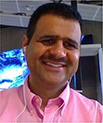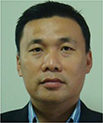Optimisation of CCS hub and its business model using novel COSMIC software
Jai Kant Pandit A * and Kwong Soon Chan AA

Dr Jai Kant Pandit has a PhD in Chemical Engineering from Monash University and has broad experience and interests in sustainability, emissions reduction, waste utilisation, hydrogen energy and power generation. Dr Pandit has been with CO2CRC for 8 years, before which he worked for Babcock & Wilcox and Alstom Power. Dr Pandit has been active in post-combustion capture project management and demonstration projects in Victoria’s Latrobe Valley on CO2 capture and hydrogen production. He is developing CO2CRC’s direct air capture technology and cost-effective, modular and hybrid HyCaps process to capture CO2. |

Kwong Soon (KS) Chan has extensive experience across the energy and resource sector, having worked in energy, oil and gas, mining, infrastructure and start-ups in Asia Pacific, Europe and the Middle East. He has gained experience working in different capacities, from field engineering, sales and marketing, operations, strategy, QHSE (Quality, Health Safety and Environment), project management, research and development to senior management. He was the Senior Manager (Carbon Capture and Utilisation Program Lead) and the Chief Commercialisation Officer with CO2CRC Limited. |
Abstract
The concept of clusters and hubs for carbon capture and storage (CCS) is gaining momentum due to its benefits of lower cost, lower liability, quick scalability and operational flexibility. Moreover, a hub can accelerate the decarbonisation efforts of various industries, including power, oil and gas, chemicals and hard-to-abate sectors. A CCS hub takes carbon dioxide from several emitters in an industrial cluster or distributed industrial sources and then transports and stores the CO2 using shared infrastructure. The concept of a CCS hub may be more complex at initial stages than a normal CCS chain due to the involvement of multiple emitters with different amounts and concentrations of CO2 emissions. A CCS hub requires long-term investment and commitment from multiple stakeholders, which requires a long-term but flexible business model. Developing such a business model requires costing different CCS hub value chain components for multiple scenarios. An up-front knowledge of the cost (capital expenditure and operational expenditure) will help the stakeholders assess profitability and risks. CO2CRC has developed a novel and comprehensive cost model, COSMIC (Costing Method for Integrated CCS chain), based on its extensive cost data, including data from various vendors, published literature and real CCS projects. COSMIC has the ability to optimise the cost of the CCS hub with regards to the emissions from the various emitters, location of capture, transport and storage hub involving multiple modes of CO2 transport. The present paper discusses how COSMIC can be used to optimise the development of the CCS hub and its business model.
Keywords: business model, CAPEX, CCS hub, CO2 transport, COSMIC, cost optimisation, OPEX, shared facilities.
 Dr Jai Kant Pandit has a PhD in Chemical Engineering from Monash University and has broad experience and interests in sustainability, emissions reduction, waste utilisation, hydrogen energy and power generation. Dr Pandit has been with CO2CRC for 8 years, before which he worked for Babcock & Wilcox and Alstom Power. Dr Pandit has been active in post-combustion capture project management and demonstration projects in Victoria’s Latrobe Valley on CO2 capture and hydrogen production. He is developing CO2CRC’s direct air capture technology and cost-effective, modular and hybrid HyCaps process to capture CO2. |
 Kwong Soon (KS) Chan has extensive experience across the energy and resource sector, having worked in energy, oil and gas, mining, infrastructure and start-ups in Asia Pacific, Europe and the Middle East. He has gained experience working in different capacities, from field engineering, sales and marketing, operations, strategy, QHSE (Quality, Health Safety and Environment), project management, research and development to senior management. He was the Senior Manager (Carbon Capture and Utilisation Program Lead) and the Chief Commercialisation Officer with CO2CRC Limited. |


